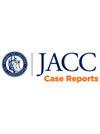利用多模态成像和三维打印模型指导复杂先天性双心室修复的决策
Q4 Medicine
引用次数: 0
摘要
背景:利用传统的二维经胸超声心动图(TTE)和横断面成像(包括心脏磁共振(CMR)和计算机断层扫描)确定复杂先天性心脏病(CHD)的最佳手术入路是具有挑战性的。一例11个月大的女性患者,表现为异位综合征、右心、双出口右心室和复杂的肺动脉瓣狭窄。胎儿超声心动图和产后TTE确立了心脏解剖的复杂性,并引发了多学科讨论,以计划复杂的分阶段心脏修复。三维(3D)打印和虚拟心脏模型,以及CMR血管造影,提供了详细的解剖可视化和空间概念化,这有助于评估分阶段双心室修复的可行性。术后CMR指导后续手术,评估新创建的结构,如挡板,并确定并发症。本病例强调了多模式成像的关键作用,包括先进的虚拟成像和3D打印建模,在复杂冠心病患者的手术计划中。本文章由计算机程序翻译,如有差异,请以英文原文为准。
Using Multimodality Imaging and 3-Dimensional Printed Models to Guide Decision-Making for Complex Congenital Biventricular Repair
Background
Determining the optimal surgical approach for complex congenital heart disease (CHD) can be challenging using conventional 2-dimensional transthoracic echocardiography (TTE) and cross-sectional imaging, including cardiac magnetic resonance (CMR) and computed tomography.
Case Summary
An 11-month-old female patient presented with heterotaxy syndrome, dextrocardia, double-outlet right ventricle, and complex pulmonary valve stenosis. Fetal echocardiography and postnatal TTE established the complexity of the cardiac anatomy and led to a multidisciplinary discussion to plan a complex staged cardiac repair.
Discussion
Three-dimensional (3D) printed and virtual heart models, along with CMR angiography, provided detailed anatomical visualization and spatial conceptualization, which aided in assessing the feasibility of a staged biventricular repair. Postoperative CMR guided subsequent surgical procedures, evaluated newly created structures such as baffles, and identified complications.
Take-Home Message
This case highlights the critical role of multimodality imaging, including advanced imaging with virtual and 3D printed modeling, in surgical planning in a patient with complex CHD.
求助全文
通过发布文献求助,成功后即可免费获取论文全文。
去求助
来源期刊

JACC. Case reports
Medicine-Cardiology and Cardiovascular Medicine
CiteScore
1.30
自引率
0.00%
发文量
404
审稿时长
17 weeks
 求助内容:
求助内容: 应助结果提醒方式:
应助结果提醒方式:


